| Coat of Arms of Hidalgo | |
|---|---|
 |
The Coat of arms of Hidalgo (Spanish : Escudo de Hidalgo, lit. "state shield of Hidalgo") is a symbol of the Free and Sovereign State of Hidalgo. [1]
| Coat of Arms of Hidalgo | |
|---|---|
 |
The Coat of arms of Hidalgo (Spanish : Escudo de Hidalgo, lit. "state shield of Hidalgo") is a symbol of the Free and Sovereign State of Hidalgo. [1]
In the center, a mountain in green, in the center, this represents the Hidalgo mountain range, as well as the crest of its mines.12 On the right side, a bronze bell hanging from a piece of wood, representing the Bell of Dolores.12 On the left, a Phrygian cap in gules, adorned with three laurel branches, these being symbols of freedom and victory, obtained with the consummation of the Independence of Mexico in 1821.
In the center is a war box, a symbol of the three great social movements of Mexico: Independence, Reform and Revolution.12 To the right, center and left, three holes in the field, symbolizing the mine entrances, which represent mining, the main economic activity of Hidalgo.
José Vasconcelos, the first Secretary of Public Education, invited Diego Rivera to make various murals in the central building of the Ministry of Education. Rivera began decorating the building in 1923 and finished it in 1928. These works reflected the ideas of the time, the life and customs of the Mexican people. The mural work is depicted on the walls of the Principal and Juárez courtyards of the building; On the first or second level of the Juarez patio is where the representations of the coats of arms of the states of Mexico are. This representation was used for a long time in various events and official ceremonies of the Government of the state of Hidalgo.
On December 14, 1979, by the decree of the L Legislature of the Congress of Hidalgo, it was officially recognized, during the period of the governor of Hidalgo, Jorge Rojo Lugo. The decree was published in the Official Gazette of the State of Hidalgo (POEH) on January 24, 1980. 6 On June 3, 2011, the Decree was issued for the purposes of printing and dissemination of the coat of arms of Hidalgo, published in the POEH on June 13, 2011. The state of Hidalgo lacks a law regulating the anthem and the use of the coat of arms of Hidalgo on January 15, 2014, an initiative was presented to create a law that regulates the use of the shield. In 2017, it was planned to create the Law of the Anthem, the Shield and the Flag of the State of Hidalgo.
The symbol is used by all successive regimes in different forms.
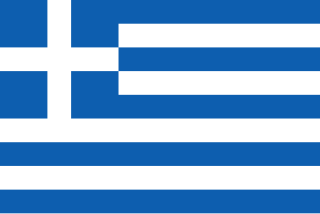
The national flag of Greece, popularly referred to as the Blue-and-White or the Cyan-and-White, is officially recognised by Greece as one of its national symbols and has 5 equal horizontal stripes of blue alternating with white. There is a blue canton in the upper hoist-side corner bearing a white cross; the cross symbolises Eastern Orthodox Christianity. The blazon of the flag is Azure, four bars Argent; on a canton of the field a Greek cross throughout of the second. The official flag ratio is 2:3. The shade of blue used in the flag has varied throughout its history, from light blue to dark blue, the latter being increasingly used since the late 1960s. It was officially adopted by the First National Assembly at Epidaurus on 13 January 1822.

The national flag of the Plurinational State of Bolivia was originally adopted in 1851. The state and war flag is a horizontal tricolor of red, yellow and green with the Bolivian coat of arms in the center. According to one source, the red stands for Bolivia's brave soldiers, while the green symbolizes fertility and yellow the nation's mineral deposits.

The national flag of the Portuguese Republic, often referred to as the Portuguese flag consists of a rectangular bicolour with a field divided into green on the hoist, and red on the fly. A lesser version of the country’s national coat of arms stands in the middle of the Portuguese armillary sphere and shield, centered over the colour boundary at equal distance. The flag was announced in 1910, following the 5 October 1910 revolution, inspired by the colours of the Republican Party and the design of radical conspiratorial society Carbonária.

The national flag of Ecuador, which consists of horizontal bands of yellow, blue and red, was first adopted by law in 1835 and later on 26 September 1860. The design of the current flag was finalized in 1900 with the addition of the coat of arms in the center of the flag. Before using the yellow, blue and red tricolor, Ecuador's former flag had three light blue stripes and two white stripes with three white stars for each province of the country. The design of the flag is very similar to those of Colombia and Venezuela, which are also former constituent territories of Gran Colombia. All three are based on a proposal by Venezuelan General Francisco de Miranda, which was adopted by Venezuela in 1811 and later Gran Colombia with some modifications. There is a variant of the flag that does not contain the coat of arms that is used by the merchant marine. This flag matches Colombia's in every aspect, but Colombia uses a different design when her merchant marine ships are at sail.

The Flag of Peru, often referred to as The Bicolour, was adopted by the government of Peru in 1825, and modified in 1950. According to the article 49 of the Constitution of Peru, it is a vertical triband with red outer bands and a single white middle band. Depending on its use, it may be defaced with different emblems, and has different names. Flag day in Peru is celebrated on 7 June, the anniversary of the Battle of Arica.

The flag of Spain, as it is defined in the Constitution of 1978, consists of three horizontal stripes: red, yellow and red, the yellow stripe being twice the height of each red stripe. Traditionally, the middle stripe was defined by the more archaic term of gualda, and hence the popular name la Rojigualda (red-weld).
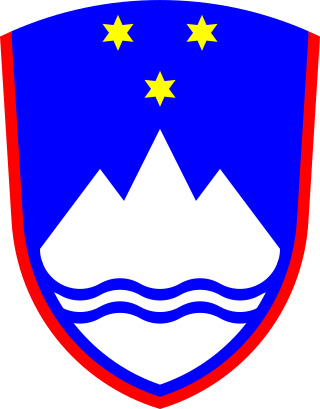
The coat of arms of Slovenia is an emblem that consists of a red bordered blue shield on which there is a stylised white Mount Triglav, under which there are two wavy lines representing the sea and the rivers of the country. Above Mount Triglav, there are three golden six-pointed stars representing the Counts of Celje. It was designed in 1991 by Marko Pogačnik and adopted on 24 June 1991.

The Panamanian coat of arms is a heraldic symbol for Panama. These arms were adopted provisionally and then definitively by the same laws that adopted the Panamanian flag.

The banderas monumentales are a collection of tall flagpoles containing large flags of Mexico located throughout Mexico. They are part of a program started in 1999 under President Ernesto Zedillo that is currently administered by the Secretariat of National Defense. The main feature of these monuments is a giant Mexican flag flying off a 50-meter-high (160-ft) flagpole. The size of the flag was 14.3 by 25 metres and it was flown on a pole that measured 50 metres (160 ft) high. In the time after the decree was issued, many more banderas monumentales have been installed throughout the country in various sizes. Many of the locations were chosen due to significant events in Mexican history that occurred there.

The National Palace is the seat of the federal executive in Mexico. Since 2018 it has also served as the official residence for the President of Mexico. It is located on Mexico City's main square, the Plaza de la Constitución. This site has been a palace for the ruling class of Mexico since the Aztec Empire, and much of the current palace's building materials are from the original one that belonged to the 16th-century leader Moctezuma II.
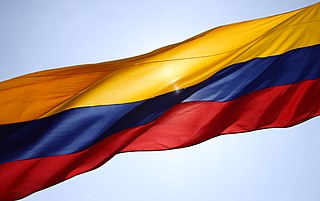
The National symbols of Colombia are the symbols which represent the national identity of the Republic of Colombia as a sovereign state. The national symbols intend to represent the Colombian identity by creating visual, verbal cultural iconic representations of the national people, values, goals, and history.
Upon the independence of Belarus from the Soviet Union, the country resurrected national symbols that were used before the Soviet era. These included a flag of red and white stripes and a coat of arms consisting of a charging knight on horseback. These national symbols were replaced by Soviet-era symbols in a disputed 1995 vote. Those two symbols, along with the national anthem, are the constitutionally defined national symbols of Belarus.

The national symbols of Mexico are the flag, the most coat of arms and the anthem. The flag is a vertical tricolor of green, white, and red. The coat of arms features a golden eagle eating a snake on top of a cactus.
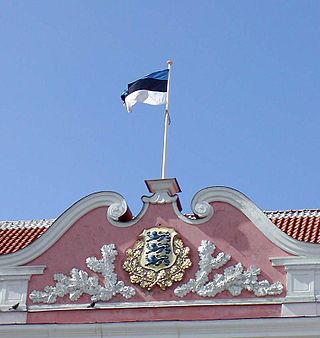
The national symbols of Estonia are flags, coat of arms, icons or cultural expressions that are emblematic, representative or otherwise characteristic of Estonia or Estonian culture.

The national flag of Mexico is a vertical tricolor of green, white, and red with the national coat of arms charged in the center of the white stripe. While the meaning of the colors has changed over time, these three colors were adopted by Mexico following independence from Spain during the country's War of Independence, and subsequent First Mexican Empire.
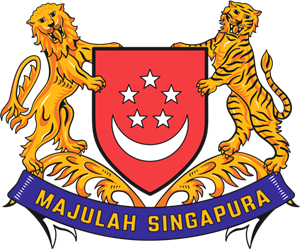
The coat of arms of Singapore is the heraldic symbol representing the sovereign island country and city-state of Singapore located in maritime Southeast Asia. It was adopted in 1959, the year Singapore attained self-governance from the British Empire, and remains in use after its independence in 1965. The committee that created it, headed by Toh Chin Chye, who was also responsible for the national flag and the national anthem of Singapore.
National symbols of Singapore are the symbols that are used in Singapore to represent what is unique about the nation, reflecting different aspects of its cultural life and history.

The current coat of arms of Guatemala was adopted after the 1871 Liberal Revolution by a decree of president Miguel García Granados. It consists of multiple symbols representing liberty and sovereignty on a bleu celeste shield. According to government specifications, the coat of arms should be depicted without the shield only when on the flag, but the version lacking the shield is often used counter to these regulations.

The coat of arms of Jalisco is a symbol of the Free and Sovereign State of Jalisco in Mexico.

The coat of arms of Querétaro is a symbol of the Free and Sovereign State of Querétaro in Mexico.